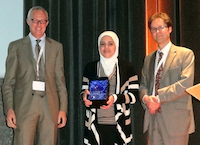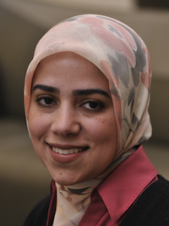The 2011 Rodolphe Maheux Award was presented to Sawsan As-Sanie at the Closing Ceremony of the 11th World Congress on Endometriosis for her work on altered regional brain morphology in women with endometriosis and chronic pelvic pain.
Dr As-Sanie and her team set out to use voxel-based morphometry (VBM) to determine whether women with chronic pelvic pain (CPP), with and without endometriosis, display changes in brain morphology, especially in regions known to be involved in pain processing, in comparison to age-matched healthy controls. Furthermore, they wished to examine if such changes are present in all women with endometriosis, or just those with chronic pain symptoms.
Methods
The team recruited three subgroups of women:
- 17 women with endometriosis-associated CPP (mean age 26.1 ± 6.3 yrs)
- 15 women with endometriosis without CPP (mean age 36.8 ± 8.6 yrs), and
- 6 women with CPP without endometriosis (mean age 24.2 ± 4.6 yrs).
These three patient sub-groups were compared to 17, 15, and 12 age-matched healthy controls, respectively. All patients with endometriosis and/or CPP were surgically-confirmed. CPP was defined as >6 months of pelvic pain, occurring for >14 days per month. Using VBM, voxelwise comparison of gray matter volume was performed between groups.
Results
Relative to age-matched controls, women with endome- triosis-associated CPP displayed decreased gray matter volume in brain regions involved in pain perception including the left (L) thalamus, L cingulate gyrus, right (R) putamen, and R insula. Women with CPP without endometriosis showed similar decreases in gray matter volume in the L thalamus.
In contrast, women with endometriosis without CPP did not display differences in regional gray matter volume except for increased gray matter volume in the R periaquaductal gray, an antinociceptive brain region.
Their data support the notion that CPP, with and without endometriosis, is associated with changes in regional gray matter volume within the central pain system.

WES President, Paolo Vercellini, and Chair of the Rodolphe Maheux Award Committee, Luk Rombauts, present Dr Sawsan As-Sanie with her award at the WCE2011 Closing Ceremony
Although endometriosis may be an important risk factor for the development of CPP, perhaps acting as source a continued peripheral nociceptive input, it is becoming increasingly clear that changes in CNS pain processing are present in women with CPP, regardless the presen- ce of endometriosis.
Their data also suggest that changes in CNS regions with antinociceptive activity are present in women with minimal pelvic pain despite having surgically-confirmed endome- triosis.
Larger prospective studies are necessary to elucidate the aetiologic relationship between endometriosis, CPP, and CNS pain regulatory systems. Such research may guide the development of diagnostic paradigms that can identify the subset of individuals with CPP that have prominent CNS contributions to their pain, as these women may not respond to peripherally directed therapies such as surgery.
About Sawsan As-Sanie

Assistant Professor Sawsan As-Sanie
Assistant Professor Sawsan (Suzie) As-Sanie is is the Director of the Minimally Invasive Gynaecology Fellowship in the Department of Obstetrics and Gynaecology at the University of Michigan. She is also the Director the University of Michigan Endometriosis Center and is dedicated to the care of women with complex gynaecologic conditions, including the treatment of women with various chronic pain disorders.
Dr As-Sanie has a particular interest in endometriosis, as well as minimally invasive surgery techniques for advanced endometriosis, and is actively engaged in numerous research studies aimed at defining the underlying mechanisms involved in the initiation and maintenance of pelvic pain disorders, with a focus on endometriosis-associated chronic pelvic pain and surgical outcomes in women with endometriosis and chronic pain.

